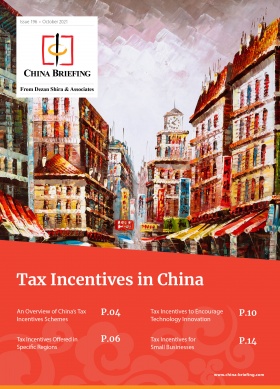China’s Tax Incentives for Small Businesses (Updated)
We list China’s major tax incentives to foster various types of small businesses.
- UPDATE (August 2, 2023): On August 2, 2023, China’s Ministry of Finance and State Taxation Administration jointly released multiple announcements, extending the preferential tax policies for small businesses to the end of 2027.The extended preferential tax policies include:
- The corporate income tax (CIT) incentives for small and low-profit enterprises (SLPE).
- The value-added tax (VAT) exemptions and reductions for small-scale taxpayers.
- The reduction of “six taxes and two fees” for small-scale taxpayers, SLPEs, and individually owned businesses.
- The individual income tax (IIT) reduction policy for individually owned businesses.
- Preferential tax treatments for small enterprises, micro enterprises, and individually owned businesses to lower financing costs.
- UPDATE (March 29, 2023): At an executive State Council meeting chaired by Premier Li Qiang on March 24, 2023, China’s State Council announced the renewal of a range of supportive tax and fee policies, which includes the long-awaited extension of corporate income tax (CIT) incentives for small and low-profit enterprises (SLPE). Following this, the Ministry of Finance and the State Taxation Administration released corresponding announcements for the implementation. The reduced CIT policy for SLPE’s portion of income that is below RMB 1 million has been extended to the end of 2024. Meanwhile, SLPE will be subject to a 20 percent CIT rate on 25 percent of the taxable income amount for the portion of taxable income not exceeding RMB 1 million during the period from January 1, 2023, to December 31, 2024. That is to say, the effective CIT rate for SLPEs’ annual taxable income below RMB 1 million will increase from 2.5 percent to 5 percent.
- UPDATE(January 10, 2023): On January 9, 2023, China’s Ministry of Finance (MOF) and the State Taxation Administration (STA) jointly issued an announcement to clarify some of its value-added tax (VAT) incentives for 2023, including the VAT exemption policy for small-scale VAT taxpayers. During the period between January 1, 2023, and December 31, 2023, small-scale taxpayers with monthly sales of under RMB 100,000 (approx. US$14,740) shall be exempted from VAT. That is to say, if the monthly sales of the small-scale taxpayer are under RMB 100,000 (approx. US$14,740), or if the quarterly sales are under RMB 300,000 (approx. US$44,220) for small-scale taxpayers who choose one quarter as a tax payment period, the taxpayer will not be subject to VAT. Meanwhile, during the same period, small-scale taxpayers that are subject to a VAT levy rate of 3 percent can enjoy a reduced levy rate of 1 percent. The VAT items that are subject to a 3 percent VAT prepayment rate shall enjoy a reduced prepayment rate of 1 percent.
- UPDATE(March 29, 2022): On March 24, 2022, the Ministry of Finance and the State Taxation Administration released a new announcement clarifying issues related to VAT exemption for small-scale VAT taxpayers. Accordingly, from April 1, 2022 to December 31, 2022, small-scale taxpayers will be exempted from VAT payment or prepayment. Moreover, the taxable sales income of small-scale VAT taxpayers earned before March 31, 2022 will be taxed at a reduced rate of one percent instead of three percent.
- UPDATE(March 18, 2023):On March 18, 2022, the Ministry of Finance and the State Taxation Administration released an Announcement on Further Implementing Preferential Income Tax Policies for Low-margin, Small Enterprises, which will be retrospectively implemented from January 1, 2022 to December 31, 2024. Accordingly, the CIT liability of small and low-profit enterprises (SLPEs) will be halved for the portion of taxable income exceeding RMB 1 million (approx. US$152,800) but less than RMB 3 million (approx. US$ 458,500). The incentive was first disclosed on the Two Sessions 2022.
China is actively creating a friendly environment conducive to the growth of small businesses, taking measures to ease the financial burdens and solve financing difficulties for small and micro firms. During the COVID-19 pandemic, these measures have been further enhanced to help affected firms weather the storm.
In this article, we introduce the major tax incentives for small businesses, including corporate income tax (CIT) cuts for small and low-profit enterprises (SLPEs), individual income tax (IIT) reduction for small business owners, as well as concessions on value-added tax (VAT) and other taxes and fees for small-scale taxpayers and tax measures to lower financing costs of small and micro enterprises.
What are China’s tax incentives for small businesses?
CIT incentives for small and low-profit enterprises
China has recently enhanced its inclusive tax cut policy for small and low-profit enterprises (SLPEs). SLPEs refer to enterprises engaged in non-restrictive and non-prohibited businesses that meet the following three conditions:
- Annual taxable income not exceeding RMB 3 million (approx. US$458,500);
- Number of employees not exceeding 300; and
- Total asset value not exceeding RMB 50 million (approx. US$7.7 million).
All types of SLPEs in China are able to enjoy a reduced corporate income tax (CIT) rate of 20 percent in combination with a reduction of their tax base. The standard CIT rate is 25 percent.
The reduction of an SLPE’s tax base was progressive before 2023, as follows:
- For the portion of taxable income not exceeding RMB 1 million (approx. US$152,800), 12.5 percent of the taxable income amount will be counted into the tax base.
- For the portion of taxable income more than RMB 1 million but not exceeding RMB 3 million (approx. US$458,500), 25 percent of the taxable income amount will be counted into the tax base.
At an executive State Council meeting chaired by Premier Li Qiang on March 24, 2023, China’s State Council announced the renewal of a range of supportive tax and fee policies, which includes the long-awaited extension of CIT incentives for SLPE. Following this, the Ministry of Finance and the State Taxation Administration released corresponding announcements for the implementation.
Under the new policy, the reduced CIT policy for SLPEs’ portion of income that is below RMB 1 million has been extended to the end of 2024. Meanwhile, SLPEs will be subject to a 20 percent CIT rate on 25 percent of the taxable income amount for the portion of taxable income not exceeding RMB 1 million during the period from January 1, 2023, to December 31, 2024.
Now according to the most recent MOF STA Announcement [2023] No.12, this CIT incentive for SLPEs will be effective until December 31, 2027.
That is to say, all SLPEs will be subject to a 20 percent CIT rate on 25 percent of their taxable income amount after the adjustment, which means the effective CIT rate for SLPEs has been unified to 5 percent during the period from January 1, 2023, to December 31, 2027.
Because the SLPE evaluation is carried out at the entity level (instead of at the group level), small subsidiaries of foreign multinational enterprises (MNEs) in China can also benefit from these CIT cuts.
|
Corporate Income Tax Cuts for Small And Low-Profit Enterprises |
||||
| Annual taxable income (ATI) | Tax base | CIT rate | Effective CIT rate | Effective period |
| Below RMB 3 million | ATI*25% | 20% | 5% | January 1, 2023 to December 31, 2027 |
VAT incentives for small-scale taxpayers
China offers value-added tax (VAT) benefits to small-scale taxpayers, including reduced VAT levy rate and increased VAT threshold.
Here, small-scale taxpayers normally refer to taxpayers whose annual VAT taxable sales do not exceed RMB 5 million (approx. US$0.77 million).
However, unincorporated entities, enterprises, and individually owned businesses that do not often incur VAT-taxable transactions, even if their annual taxable sales exceed the stipulated standard, can choose to be treated as small-scale taxpayers (instead of being registered as general taxpayers).
VAT exemption
On January 9, 2023, the MOF and STA jointly issued an announcement to clarify some of its VAT incentives for 2023, including the VAT exemption policy for small-scale VAT taxpayers. The Announcement on Clarifying VAT Exemption and Other Policies for Small-Scale VAT Taxpayers [MOF STA Announcement [2023] No.1] (hereinafter the “small-scale taxpayer policies”) will be applied during the period between January 1, 2023, and December 31, 2023.
The small-scale taxpayer policies clarify that during the period between January 1, 2023, and December 31, 2023, small-scale taxpayers with monthly sales of under RMB 100,000 (approx. US$14,740) shall be exempted from VAT.
That is to say, if the monthly sales of the small-scale taxpayer are under RMB 100,000 (approx. US$14,740), or if the quarterly sales are under RMB 300,000 (approx. US$44,220) for small-scale taxpayers who choose one quarter as a tax payment period, the taxpayer will not be subject to VAT.
Now, according to the most recent MOF STA Announcement [2023] No.19, this VAT exemption policy will be effective until December 31, 2027.
This threshold is a bit lower than that in 2021 and 2022. During the period from April 1, 2021, to December 31, 2022, the VAT threshold for small-scale taxpayers was RMB 150,000 (approx. US$22,110) per month (or RMB 450,000 per quarter, approx. US$66,300).
| VAT Liability Threshold for Small-Scale Taxpayers, 2021 to 2027 | ||
| Monthly sales | Quarterly sales | Effective period |
| RMB 100,000 | RMB 300,000 | January 1, 2021, to March 31, 2021 |
| RMB 150,000 | RMB 450,000 | April 1, 2021, to December 31, 2022 |
| RMB 100,000 | RMB 300,000 | January 1, 2023, to December 31, 2027 |
Meanwhile, the VAT administration notice clarifies that small-scale taxpayers with total monthly sales of over RMB 100,000, but whose sales when excluding real estate sales occurring in the current period is less than RMB 100,000, will be exempt from paying VAT on the sale of goods, labor services, services, and intangible assets.
Small-scale taxpayers can choose to waive the VAT exemption incentive and instead issue special VAT invoices for a specific sale.
Reduced VAT rates
The small-scale taxpayer policies clarify that between January 1, 2023, and December 31, 2023, small-scale taxpayers subject to a VAT levy rate of 3 percent can enjoy a reduced levy rate of 1 percent. The VAT items that are subject to a 3 percent VAT prepayment rate shall enjoy a reduced prepayment rate of 1 percent.
Previously, during the period from April 1, 2022, to December 31, 2022, small-scale VAT taxpayers that are subject to a VAT levy rate of 3 percent will be exempted from VAT payment or prepayment.
The VAT administration notice clarifies that small-scale taxpayers can choose to waive the VAT reduction incentive and instead issue special VAT invoices for a specific sale.
Now, according to the most recent MOF STA Announcement [2023] No.19, this VAT reduction policy will be effective until December 31, 2027, as well.
Education surcharge and other tax reduction
China’s national and local education surcharges are calculated based on a taxpayer’s actual payment of VAT and consumption tax.
At present taxpayers whose sales amount does not exceed RMB 100,000 per month (or RMB 300,000 per quarter) will be exempt from education surcharge, local education surcharge, and water conservancy construction fund.
Aside from the exemption of education surcharges, taxpayers can keep an eye on additional tax and fee relief offered locally.
Previously, as per the MOF STA Announcement [2022] No.10, small-scale taxpayers, SLPEs, and individually owned businesses could enjoy the reduction of “six taxes and two fees” within 50 percent of the tax amount (as decided by provincial governments) before December 31, 2024.
|
What Are the “Six Taxes and Two Fees” in China? |
| Six taxes refer to: |
| 1. Urban maintenance and construction tax
2. Property tax 3. Urban and township land use tax 4. Stamp tax (excluding securities transaction stamp tax) 5. Farmland occupation tax 6. Resource tax (excluding tax on water resources) |
| Two fees refer to: |
| 1. Education surcharges
2. Local education surcharges |
Now, according to the most recent MOF STA Announcement [2023] No.12, the reduction ratio of “six taxes and two fees” for small businesses shall be fixed at 50 percent, rather than a ratio within 50 percent as decided by the provincial government, and this preferential tax policy will be effective until December 31, 2027.
The MOF STA Announcement [2023] No.12 also clarifies that small businesses can still enjoy this 50 percent reduction of the “six taxes and two fees” policy even if they have enjoyed other preferential treatment of the “six taxes and two fees” according to law.
IIT incentives for individually owned businesses
Previously, individually owned businesses could enjoy a 50 percent reduction of their payable IIT amount for the portion of taxable income not exceeding RMB 1 million (approx. US$152,800) before December 31, 2024.
Now, according to the most recent MOF STA Announcement [2023] No.12, the ceiling of the taxable income that is eligible for this IIT incentive for individually owned businesses has been raised to RMB 2 million (approx. US$305, 600), and this preferential tax policy will be effective until December 31, 2027.
In addition, from April 1, 2021, individually owned businesses, sole proprietorship enterprises, partnership enterprises, and individuals will no longer be required to pre-pay IIT at the time of issuance of cargo transport VAT invoices on behalf.
Tax measures to lower financing costs of small businesses
To help small and micro enterprises raise funds, China exempts financial institutions from paying VAT on their interest income derived from small loans to farmers, small enterprises, micro-enterprises, and individually owned businesses. Besides, loan contracts signed between small or micro-enterprises and financial institutions are exempt from stamp duty.
Small enterprises and micro enterprises refer to those that comply with the Small and Medium-Sized Enterprises Classification Standard Regulations. (For more details, please refer to our China Briefing Article here)
Small loans refer to loans for small enterprises, micro-enterprises, or individually owned businesses with a bank credit of less than RMB 1 million (including the principal amount). If the small business has no bank credit, the small loans refer to loans of a single business where both the loan contract amount and the loan balance are below RMB 1 million (including the principal amount).
Previously, both measures are effective until December 31, 2023.
Now, according to the most recent MOF STA Announcement [2023] No.13, these preferential VAT and stamp tax policies for lowering financing costs of small businesses will be effective until December 31, 2027.
(This article was originally included in the China Briefing Magazine issue Tax Incentive in China, and was last updated on August 14, 2023)
China Briefing is written and produced by Dezan Shira & Associates. The practice assists foreign investors into China and has done so since 1992 through offices in Beijing, Tianjin, Dalian, Qingdao, Shanghai, Hangzhou, Ningbo, Suzhou, Guangzhou, Dongguan, Zhongshan, Shenzhen, and Hong Kong. Please contact the firm for assistance in China at china@dezshira.com.
Dezan Shira & Associates has offices in Vietnam, Indonesia, Singapore, United States, Germany, Italy, India, and Russia, in addition to our trade research facilities along the Belt & Road Initiative. We also have partner firms assisting foreign investors in The Philippines, Malaysia, Thailand, Bangladesh.
- Previous Article China Clarifies 2023 VAT Incentives for Small-Scale Taxpayers and Lifestyle and Production Oriented Services
- Next Article China’s Average Wages – Trends and Implications for Businesses








